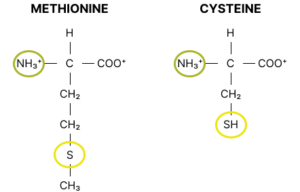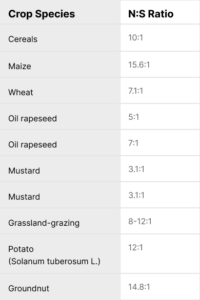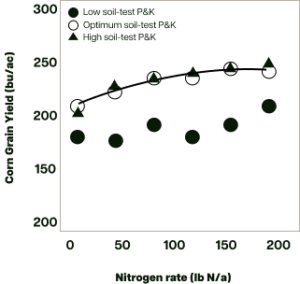Getting nutrients right makes all the difference. Nitrogen and sulfur are present in every living cell and play pivotal roles in plant development. Symptoms can often be confused; however, there are intricacies in how nitrogen or sulfur deficiencies in crops express symptoms, plant growth, and nutrient use efficiency.
The significance of nitrogen and sulfur in crop nutrition
Nitrogen and sulfur are vital components in the complex system of plant nutrition. Nitrogen is a key element in chlorophyll formation, protein synthesis, and overall plant growth. Sulfur is essential for the production of the Amino Acids cysteine & methionine and enzyme function. Both nutrients contribute significantly to crop health, yield, and quality.
Sulfur containing amino acids

Source: Adapted from Zenda et al, 2021 Revisiting Sulphur-The Once Neglected Nutrient: It’s Roles in Plant Growth, Metabolism, Stress Tolerance and Crop Production. J & M Brosnan J. of Nutrition 2006.
The relationship between nitrogen and sulfur in various crops

Source: Adapted from Zenda et al, 2021 Revisiting Sulphur-The Once Neglected Nutrient: It’s Roles in Plant Growth, Metabolism, Stress Tolerance and Crop Production. J & M Brosnan J. of Nutrition 2006.
Understanding sulfur and nitrogen deficiencies
Nitrogen deficiency can severely impact crop productivity. Understanding its symptoms and addressing them promptly is key for maintaining healthy crops. While often overlooked, sulfur deficiency can also significantly impact crop health and yield.
The earlier you can recognize nutrient deficiency symptoms, the more accurately you can make management decisions.
Comparing nitrogen and sulfur deficiencies
While both nitrogen and sulfur deficiencies are often confused for one another and can significantly impact crop health, there are key differences in their symptoms and management:

Diagnosing nitrogen deficiency
The yellowing of older leaves is a telltale sign of nitrogen deficiency. This occurs because nitrogen is a mobile nutrient within the plant, and when in short supply, it’s redistributed from older to younger leaves to support new growth.
Management recommendations for nitrogen deficiency
- 1. Account for nitrogen credits such as manure, previous crop, soil organic matter etc.
- 2. Implement a balanced fertility program using nitrogen fertilizers ahead of plant needs as a foundation for early season growth.
- 3. Adopt split application techniques, applying nitrogen in multiple doses to match plant growth stages and reduce leaching losses
Diagnosing sulfur deficiency
The yellowing of new leaves from sulfur deficiency occurs because sulfur is less mobile within the plant compared to nitrogen. This results in deficiency symptoms appearing first in younger plant tissues at the top of the plant. Regular tissue and soil tests can help identify deficiencies and trends in nutrient levels as reflective from crop and field management. Sulfur is mobile in the soil. Soil tests may not be accurate for making recommendations. Tissue testing; however, can be a useful tool in diagnosing sulfur deficiencies in plants.
Corrective measures for sulfur deficiency
- 1. Apply sulfate-containing fertilizers such as Kmag, for immediately plant-available sulfur.
- 2. Consider products like MicroEssentials S10®/SZ® as part of a core soil fertility program, which provide both immediate and slow-release sulfur for season-long sulfur availability.
The importance of soil testing and balanced fertility programs
Regardless of the specific nutrient deficiency, soil testing remains the cornerstone of effective nutrient management. Regular complete soil tests provide valuable insights into the nutrient status of the soil, allowing farmers to make informed decisions about fertilizer application. Identifying other yield limiting nutrients may be the key to making nitrogen and sulfur work more efficiently for your crop.
The table below illustrates the optimum soil-test P & K level required to achieve N response, ROI, and efficient N use.

Source: Improving Phosphorus and Potassium Management Considerations and Lessons Learned, John Jones, PhD, CCA Department of Soil Science, University of Wisconsin-Madison
A balanced fertility program takes into account:
- • Specific crop needs
- • Soil type and characteristics
- • Environmental conditions
- • Previous crop history
By integrating regular soil testing with a tailored fertility program, farmers can prevent nutrient deficiencies, optimize crop growth, and maximize yield potential.
How MicroEssentials helps combat nutrient deficiencies
MicroEssentials is specifically designed to address nitrogen and sulfur deficiencies through several key mechanisms:
- • Season-Long Sulfur Availability: MicroEssentials provides sulfur in both sulfate and elemental forms, ensuring immediate and long-term sulfur availability throughout the growing season.
- • Fusion Technology: MicroEssentials packs the nutrients growers need into a single granule, promoting uniform nutrient distribution and enhancing nutrient uptake.
- • Balanced Nutrient Blend: Each granule contains a precise combination of nitrogen, phosphorus, and sulfur addressing multiple nutrient needs simultaneously. The MicroEssentials SZ formulation also includes zinc. MicroEssentials offers slow-release properties, reducing nutrient loss and improving overall nutrient use efficiency.
As our understanding of plant nutrition continues to evolve, staying informed about the latest research and innovative products like MicroEssentials will be crucial for maintaining healthy crops and achieving bountiful harvests in the face of nutrient challenges.